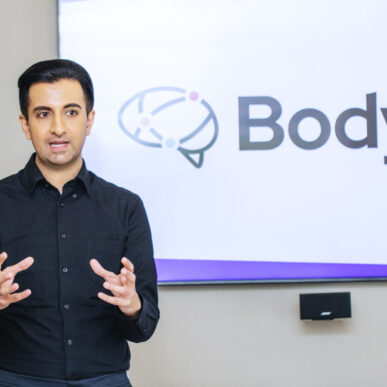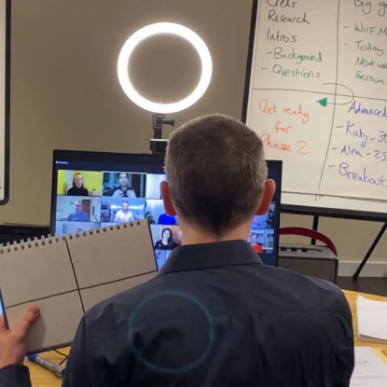Imagine stepping in front of an audience and delivering a presentation where every word resonates, each slide captivates, and by the end, your listeners are fully engaged and inspired to take action. This level of impact isn’t just a lofty goal—it’s entirely achievable when you truly understand your audience.
Knowing who you are speaking to and tailoring your message accordingly can make the difference between a presentation that resonates and one that falls flat.
Whether you’re addressing a small team, a room full of executives or a diverse conference, understanding your audience is paramount. Knowing your audience enables you to connect with them on a deeper level, ensuring that your message is not only heard but also understood, remembered and acted upon.
In this blog, we will look at seven questions you can ask that will help you connect with your audience, tailor your content to their needs, and ultimately deliver more impactful presentations.
How to understand your audience
There are a number of questions that you should ask yourself before preparing a presentation. Some of these questions may seem obvious, but having answers to them will help you to better understand your audience and prepare content that they will engage with.
1. Who is going to be in your audience?
Sounds pretty obvious, I know, but this is where you should begin. What do you know already about who your audience is? How many people will there be? Are they internal or external? Are they senior executives, middle managers, or junior employees?
Start out by identifying the demographics, roles, and experience levels of your audience members. Go into as much detail as you can. This will give you a good foundation for planning your presentation focused around that particular audience.
Once you’ve identified who they are, there are further questions you should ask…
2. What do they care about?
Understanding what your audience cares about is fundamental in planning a successful presentation. What’s happened in the past that has affected them? What issues are affecting them currently? What is most important to them?
When you know the interests, needs and concerns of your audience, you can tailor your message to directly address these points, capturing their attention and maintaining their engagement throughout.
If you align your presentation with what your audience cares about, it will also make it more persuasive. By framing your arguments and recommendations in terms that resonate with their values and priorities, you increase the likelihood that they will be convinced of your ideas. This shows respect for their perspectives but also allows you to adapt your presentation dynamically based on their reactions.
3. What are their pain points?
Understanding your audience’s pain points can help you to craft a much more engaging presentation which will resonate on an emotional level. What’s their biggest challenge at the moment? What keeps them awake at night?
By tapping into your audience’s concerns, you will demonstrate an understanding of their world, allowing for deeper connections and trust to form. By focusing on a challenge that your audience cares about, you’re more likely to keep people’s attention for longer, as information will feel much more relevant and useful to them.
4. Is there a consistency of knowledge amongst your audience?
This is an important question to answer. Too many presentations assume that the audience has a specific level of existing knowledge about a subject – but this assumption can be problematic. If some of your audience does not understand your content, they’re likely to switch off or disengage.
What do people know about your subject already? Is there a common level of knowledge which already exists, or are there mixed levels of understanding on the subject? Will all of your audience understand any business-specific jargon or technical vocabulary?
Identify the range of knowledge levels that you have. You might have beginners, intermediates and experts.
If you do have mixed levels of understanding, you may need to think about a layered approach to sharing your content: start with basic concepts and gradually introduce more complex information. Be wary of using any technical language which may exclude some members of your audience. Make sure your presentation is inclusive and easy-to-follow.
5. What is their preferred communication style?
What do you know about how your audience likes to receive information? Different audiences prefer different presentation styles. Some might appreciate a formal, data-driven approach, while others might respond better to a more conversational and interactive style.
Find out what you can about your audience’s preferences and be prepared to tailor your style accordingly. Your audience will really appreciate it if you make the effort to speak to them in the way they prefer to be spoken to.
6. What are their expectations?
What is your audience expecting to take away from your presentation? For example, how has it been advertised to them? What have they been told about it? Are they expecting a high-level overview, detailed analysis, actionable steps, or a combination of these? How would you summarise what they’d like to learn from you? What specific questions will your presentation need to answer?
Knowing your audience’s expectations will help you to plan for a presentation which will leave them feeling engaged and fulfilled. If their expectations are different to what you’re able to deliver, you’ll be able to manage these expectations at the beginning by being clear about what you can and cannot do.
7. What does your audience need to hear?
Ultimately, your audience only really cares about what they need to hear.
Think carefully about what your audience needs. If you can give people that information from start to finish, in the right order, they’ll be compelled to listen and will feel connected with you.
Aristotle’s principles of ethos, pathos and logos are useful here.
Ethos: Your credibility and character. What does your audience need to know about you in order to trust that you’re the right person to deliver the information?
Pathos: An emotional connection. What will your audience gain by listening to you? What benefits will your audience receive from your presentation?
Logos: What is the logical, rational, factual information that your audience will need to take from your presentation in order to be convinced by it?
By taking time to ask and answer these questions, you will be able to craft a much more compelling presentation that resonates with and captivates your audience.
What to do if you don’t know anything about your audience?
If you have no prior knowledge of your audience, you’ll need to adopt a flexible and strategic approach.
Begin by crafting a broad outline that covers fundamental aspects of your topic while allowing room for adjustments based on audience engagement and feedback. Focus on universal themes and examples that are likely to resonate with a diverse group. Avoid overly specific references or assumptions about their background or expertise levels.
Incorporating interactive elements like polls or Q&A sessions during your presentation can help gather insights and tailor your content on the fly.
Afterwards, seek feedback if you can to better understand your audience’s needs and preferences, so that your future presentations are more targeted and effective.
Perfect your presentations with us
Taking time to really hone your business speaking skills can transform your confidence and success in communication.
Whatever your level, whether you’re a novice or much more experienced, we’d love to help you to develop and improve to ensure you’re connecting with your audience every time. Contact our team today to see how we can help you.



















